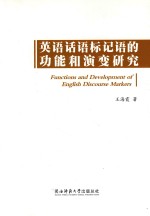图书介绍
英语话语标记语的功能和演变研究 英文【2025|PDF下载-Epub版本|mobi电子书|kindle百度云盘下载】

- 王海霞著 著
- 出版社: 陕西师范大学出版总社
- ISBN:9787561381878
- 出版时间:2015
- 标注页数:184页
- 文件大小:25MB
- 文件页数:196页
- 主题词:英语-语用学-研究
PDF下载
下载说明
英语话语标记语的功能和演变研究 英文PDF格式电子书版下载
下载的文件为RAR压缩包。需要使用解压软件进行解压得到PDF格式图书。建议使用BT下载工具Free Download Manager进行下载,简称FDM(免费,没有广告,支持多平台)。本站资源全部打包为BT种子。所以需要使用专业的BT下载软件进行下载。如BitComet qBittorrent uTorrent等BT下载工具。迅雷目前由于本站不是热门资源。不推荐使用!后期资源热门了。安装了迅雷也可以迅雷进行下载!
(文件页数 要大于 标注页数,上中下等多册电子书除外)
注意:本站所有压缩包均有解压码: 点击下载压缩包解压工具
图书目录
Chapter 1 The Present State of Research on Discourse Markers1
1.1 Introduction1
1.2 Discourse Markers in Previous Studies1
1.2.1 Diversity in Terminology and Definition1
1.2.2 Theoretical Approaches4
1.2.2.1 Pragmatic Perspective4
1.2.2.2 Relevance Theoretic Approach5
1.2.2.3 Coherence-based Functional Approach7
1.2.2.4 Aijmer's Functional Perspective10
1.2.2.5 Diachronic Approach11
1.2.3 Functional Domains of Discourse Markers13
1.3 Overview of the Current Study15
1.3.1 A Corpus-linguistic Approach15
1.3.2 The Corpus Used in This Research16
1.3.3 Outline of This Study18
1.3.4 Significance of This Study21
Chapter 2 Conceptual Background of the Current Study23
2.1 Introduction23
2.2 Sentence Adverbial24
2.2.1 Features of Sentence Adverbials25
2.2.2 Syntactic Realizations of Sentence Adverbials25
2.2.3 Functions of Sentence Adverbials26
2.2.3.1 Marking the Speaker's Epistemic Stance27
2.2.3.2 Expressing the Speaker's Attitude and Evaluation28
2.2.3.3 Commenting on the Style or Manner of Speaking29
2.3 Comment Clause31
2.3.1 Features of Comment Clauses32
2.3.2 Categories of Comment Clauses32
2.3.3 Functions of Comment Clauses33
2.3.3.1 Expressing the Speaker's Doubt or Certainty34
2.3.3.2 Expressing the Speaker's Attitude and Evaluation34
2.3.3.3 Conveying Comments on the Manner of Speaking36
2.3.4 Non-clausal Sentence Adverbial and Comment Clause36
2.4 Discourse Marker37
2.4.1 Features of Discourse Markers37
2.4.2 Categories of Discourse Markers38
2.4.3 Functions of Discourse Markers38
2.4.3.1 Textual Functions38
2.4.3.2 Interpersonal Functions40
2.5 Sentence Adverbial,Comment Clause and Discourse Marker41
2.6 Discourse Markers and Grammaticalization43
2.6.1 Introduction43
2.6.2 Development of Discourse Markers45
2.6.2.1 Semantic-pragmatic Changes45
2.6.2.2 Syntactic Reanalysis46
2.6.3 Are Discourse Markers an Example of Grammaticalization?51
2.6.3.1 Features Typical of Grammaticalization52
2.6.3.2 Principles of Grammaticalization53
Chapter 3 Actually:From a Phrase Adverbial to a Discourse Marker55
3.1 Introduction55
3.2 Phrase Adverbial57
3.2.1 Emphasizer57
3.2.2 Intensifier58
3.3 Sentence Adverbial60
3.3.1 Going beyond Conventionally Formed Expectations60
3.3.2 Conflicting with Textually Based Expectations61
3.4 Discourse Marker63
3.4.1 Textual Functions63
3.4.1.1 Marker of Contradiction63
3.4.1.2 Marker of Elaboration65
3.4.1.3 Marker of Topic Shift68
3.4.2 Interpersonal Functions70
3.4.2.1 Softening the Contradiction70
3.4.2.2 Mitigating the Abruptness71
3.5 Development of Actually72
3.6 Conclusion73
Chapter 4 (A)Kind of:From a Noun Phrase to a Discourse Marker74
4.1 Introduction74
4.2 A Kind of as a Noun-preposition Sequence76
4.2.1 A Noun Phrase Meaning a Type of76
4.2.2 A Nominal Premodifier Signaling Fuzziness77
4.3 (A)Kind ofas a Metalinguistic Hedge79
4.3.1 Imprecision Signal79
4.3.2 Special-style Signal83
4.4 (A)Kind of as a Discourse Marker85
4.4.1 Interpersonal Function85
4.4.1.1 Mitigating the Assertive Force86
4.4.1.2 Appealing to Common Ground89
4.4.2 Textual Function91
4.5 Variants of Kind of93
4.6 Development of(a)Kind of95
4.7 Conclusion98
Chapter 5 The Thingis:A Discourse Marker Originating from a Matrix Clause99
5.1 Introduction99
5.2 Identifying the Relevant Item101
5.2.1 Non-parenthetical the Thing is103
5.2.2 Parenthetical the Thing is103
5.2.3 Structurally Indeterminate the Thing is104
5.3 Functions of Parenthetical the Thing is105
5.3.1 Comment Clause Use105
5.3.2 Discourse Marker Use107
5.3.2.1 Marker of Justification107
5.3.2.2 Marker of Contradiction108
5.3.2.3 Marker of Topic Shift109
5.3.2.4 Hesitation Filler111
5.4 Thing is113
5.5 Development of the Thing is114
5.6 Conclusion117
Chapter 6 You Know What:A Discourse Marker Originating from a Full Interrogative118
6.1 Introduction118
6.2 Identifying the Relevant Item121
6.2.1 Non-parenthetical You Know What121
6.2.1.1 Proposition-deleted Interrogative121
6.2.1.2 Deictic Use of You Know What123
6.2.2 Parenthetical You Know What124
6.3 Functions of Parenthetical You Know What124
6.3.1 Comment Clause Use125
6.3.2 Discourse Marker Use126
6.3.2.1 Boundary Marker126
6.3.2.2 Marker of Justification128
6.3.2.3 Marker of Elaboration129
6.3.2.4 Marker of Topic Shift131
6.3.2.5 Hesitation Filler133
6.4 Development of You Know What134
6.4.1 Full Interrogative134
6.4.2 Rhetorical Interrogative135
6.4.3 Proposition-deleted Rhetorical Interrogative136
6.4.4 Comment Clause137
6.4.5 Discourse Marker137
6.5 Conclusion138
Chapter 7 Different Discourse Markers Used as Hesitation Fillers140
7.1 Introduction140
7.2 Differences between Different Discourse Markers140
7.3 Conclusion145
Chapter 8 Conclusion147
8.1 Main Findings of This Study147
8.2 Reformulation of the Related Dictionary Entries148
8.2.1 Actually149
8.2.2 (A)Kind of150
8.2.3 The Thing is151
8.2.4 You Know What152
8.3 Influence of This Research on English Education in China154
8.4 Directions of Further Research154
Bibliography157
热门推荐
- 1696696.html
- 1781898.html
- 703736.html
- 1552162.html
- 1625552.html
- 3547066.html
- 300980.html
- 1450635.html
- 2156273.html
- 924152.html
- http://www.ickdjs.cc/book_3329336.html
- http://www.ickdjs.cc/book_563449.html
- http://www.ickdjs.cc/book_2151458.html
- http://www.ickdjs.cc/book_3753327.html
- http://www.ickdjs.cc/book_656775.html
- http://www.ickdjs.cc/book_784220.html
- http://www.ickdjs.cc/book_1250200.html
- http://www.ickdjs.cc/book_3845401.html
- http://www.ickdjs.cc/book_2638558.html
- http://www.ickdjs.cc/book_1967571.html